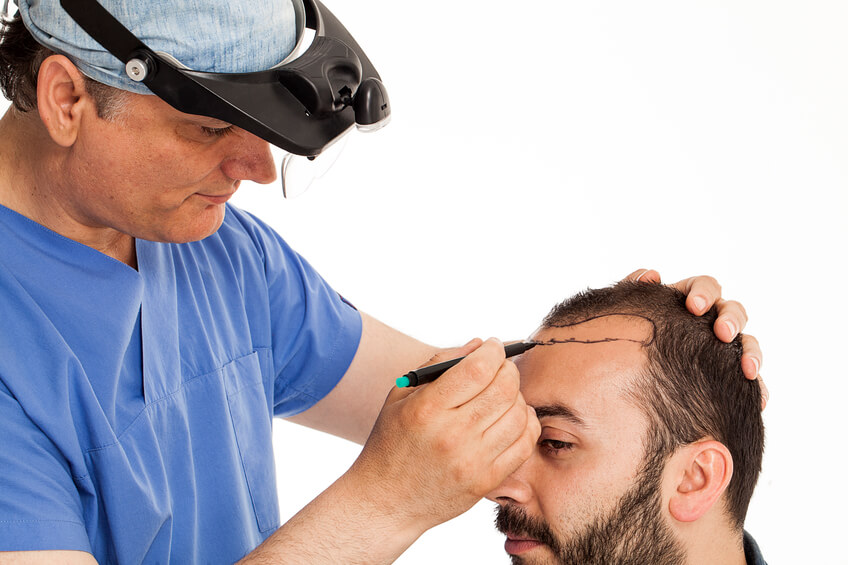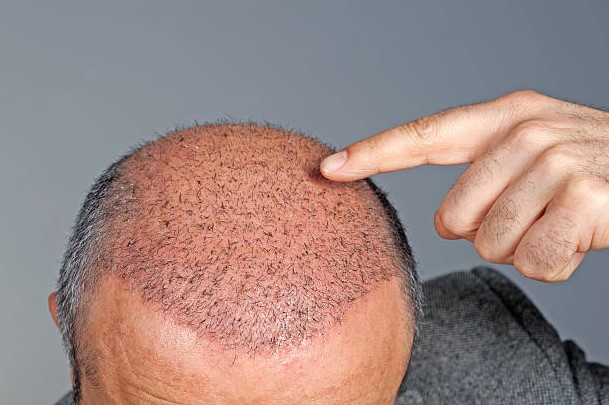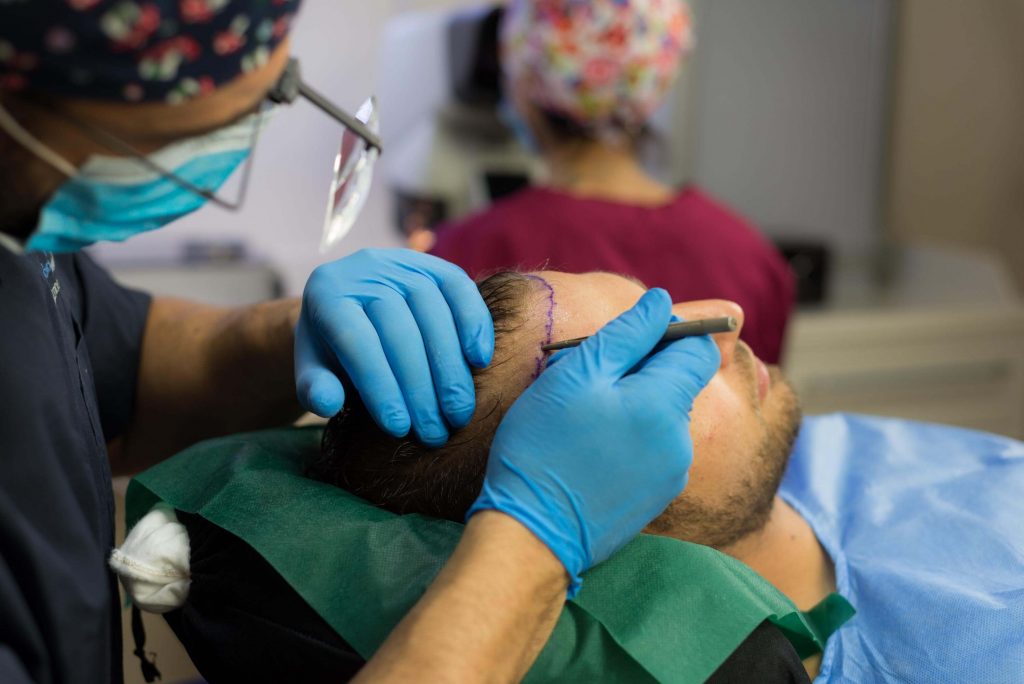What is a hair transplant?
Hair transplant, or what is also called hair transplantation, hair grafting or hair implants, is a type of cosmetic surgery that makes your head hair thicker. In this procedure, donor hair is taken from the back areas of the scalp, beard, or chest and moved to the areas of hair loss. Then it continues to grow in the new place. American Academy Dermatology has announced that more than 80 million people (men and women) experience hair loss. Every person’s head naturally loses between 50 to 100 hairs a day. However, it is not the same for bald spots, a receding hairline, and a thinning part. They have a bigger loss. The most common reason for this disharmony is genetic which is called androgenic alopecia or male-female pattern baldness. Men experience it with receding hairline in the crown and women experience it with recession near the temples and a widening part line. Here, a hair transplant comes to help as it usually restores the lost hair. But, keep in mind that it can be useful provided that the hair loss has not developed too far.
A hair transplant is done for men more than women. According to some specialists, 85 percent of this surgery is done on men.


Hair transplant procedure
At first, the surgeon cleans your scalp. Then he/she uses a small needle to make local anesthesia. The next step activity depends on the type of surgery. There are two main techniques for this surgery:
Which one is better, FUT or FUE method?
Several factors have a role in deciding the method some of which include:
- The density of the donor area at the back of the scalp
- The amount of hair needed to harvest
- How you like to cut the hair
FUT advantage is that the hair is completely harvested from within a safe zone. The safe zone is the area at the scalp that has more resistance to hair loss and is the best to be used in hair transplantation. Since only a thin strip is harvested, the hair can be left long enough to cover the stitches and wounds. The disadvantage is that the multiple stitches have to stay for about 10 days before removal.
In FUT, which is a more popular technique, the back of the scalp has to be shaved and each punch leaves a tiny hole and creates a round scar. But, when the round scars heal the hair starts to grow again and the scars get hidden.
The disadvantage is that if you need to harvest many follicles some hair may be needed to be harvested from outside the safe zoon. As time goes on, the transplanted hairs may be vulnerable to future losses. Also, this technique will lead to more damaged follicles in the process.
It is the role of your surgeon to match the best technique with your condition. He/she will do it with his/ her experience, knowledge and skill.

Hair transplant risks and complications
Hair transplant is a type of surgery, so you must consider these problems:
- Numbness
One probable hair transplant danger is the areas of numbness after the procedure. If the nerves in the donor or transplant site get damaged it causes numbness. Though in some cases numbness is temporary, in others it can be permanent.
- Scaring
This surgery can cause scarring, but if it is successful the new hair will cover them. However, your hair may reject the hair transplant. Then, there will be a noticeable scar in the bald area. Some factors such as skin sensitivity, the way the hair transplant is done, and the surgeon’s skill of doing the procedure determine the amount of surgery.
- Infection
The surgeon may prescribe antibiotics before the surgery and anti-inflammatory after the hair transplant to prevent infection. But, sometimes serious infections happen.
- Allergic reaction
Hair transplant procedure is done under local anesthesia which has the danger of allergic reaction. It can also cause other reactions such as central nervous system problems or cardiac reactions. They happen rarely, but they can be deadly.
- Rejection
Your body may reject the hair transplant despite the surgery seems successful. It may don’t have physical harm, but makes you disappointed from the surgery and out of money.
- Hair curl
Hair curl means that the transplanted follicle under the scalp gets cured. It can result in ingrown hair and infection. If hair curl happens for a large number on the transplanted hair, the result will appear unnatural.
Grafts fail to take hair transplantation
If your grafts do not take to the scalp the surgery repetition will be required.
Other hair transplant complications include:
- Scalp laxity
- Scalp bleeding and swelling
- Itching
- Shock loss

Hair transplant recovery
The complexity of the surgery will influence how you feel after hair transplants. You can control Excessive tightness, any aching or throbbing with medication that the surgeon prescribes. Bandages are usually removed after a day. You can wash your hair gently after 2 days. Stitches are removed after 10 days.
Avoid strenuous activities and vigorous exercise, since they cause hair transplant and the incisions to bleed. Also, sexual activity should be avoided for 10 days.
Some candidates are curious to know how soon they will resume a normal routine. The answer is that it depends on the type of surgery and its length and complexity.
Naturally, you experience hair fall out within six weeks. It will take another 6 weeks to grow again.
The last point is that you may need a touch up surgical procedure. It is done to create more natural-looking results after incisions heal.
Hair transplant pros , cons and cost
- If the transplant is done properly the hairs in the new area will grow permanently
- Very little prep is required
- It looks extremely natural if done properly
- Especially in FUE, most patients won’t need medication
- Progression of hair loss can be contentious and hair transplant won’t stop it unless prevention therapy is done.
- If a hair transplant is not done properly, it can damage the area around it.
- Not all of the implanted hair will survive.
- Slight scarring will be left on your scalp depending on the type of surgery.
- If hair transplant surgery goes wrong, the hair can look unnatural.
- It is expensive and the insurance usually does not cover it.
American Society of Aesthetic Plastic surgery has declared the cost of this surgery 5.033 dollars. But many surgeons charge a per-graft fee. It usually costs between 3 to 10 dollars per graft. Thus, the final cost will depend on the number of grafts and the amount of your hair loss. Some doctors say that it can go as high as 18000 dollars.
Charging by grafts can be confusing since their number does not correlate to hair number. One graft may have for hair, as an example, another graft has a single hair.
A hair transplant also has some additional costs. Most of the patients need additional work after the first surgery to make the hair look more natural.
Sometimes the procedure can result in complications. As an example, the grafts fail to attach and grow. In these cases, the hair transplant must be replaced at the patient’s expense.
Dr. Salahi performs hundreds of abdominal and thoracic surgeries, abdominal lipatomics, lipomatic abdominal surgery, thighs and arms, breast prosthesis and minimally invasive surgeries and is one of the top-ranked doctors in Tehran in cosmetic surgery. They specialize in cosmetic surgery.
Are there any alternatives for hair transplant?
If you want to avoid surgery you have some other choices to make your hair thicker.


Who is a qualified surgeon for a hair transplant?
A hair transplant is not only a type of surgery but also a type of art. So, the surgeon should have both technical and artistic skills
The most basic qualification that is necessary for a hair transplant surgeon is being a licensed medical doctor. But, it is not enough and there are many additional qualifications. He/she must have extensive training in transplantation other than dermatology and plastic surgery. A hair transplant surgeon who specializes in this field is also a plastic surgeon or a dermatologist.
The surgeon must be board certified. The well-known American Board of Hair Surgery is an organization that offers board certification in this field. However, keep in mind that a certification does not guarantee that the surgeon will do it very properly. Thus, you need to get information before choosing any surgeon.
Experience is a crucial factor and your doctor must be honest in telling about his/her experience and showing you before and after photos.
A qualified hair transplant surgeon also is the one who has an excellent team that is responsible for graft preparation. The last important thing is that your surgeon must be able to understand your hair loss well, estimate the future loss, and plan for subsequent needed sessions. At the same time, he must use his/her artistic talent and pay very careful attention to making a natural-looking final result.
Who is a good candidate for a hair transplant?
For getting hair transplantation you should be at least 20 since till then it is difficult to know how much hair loss you will experience in the future. When you get older it is easier to see signs of balding and loss hairline. Also, you need mental growth, young patients have unrealistic expectations from the surgery.
Your donor hair should be healthy so that the surgeon can harvest it. As mentioned earlier, your hair loss shouldn’t be big. If all over the head is significantly thinning, hair transplant won’t be right for you.



